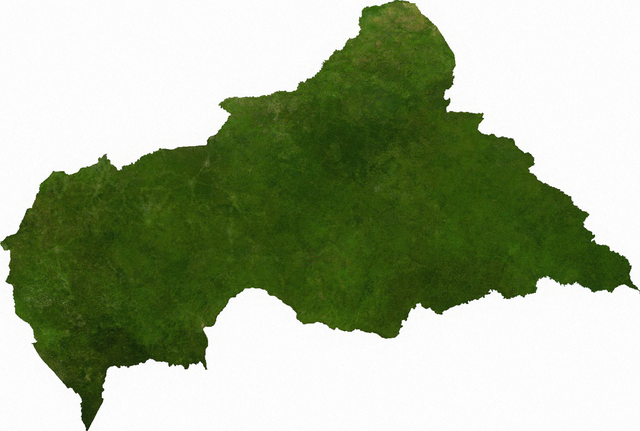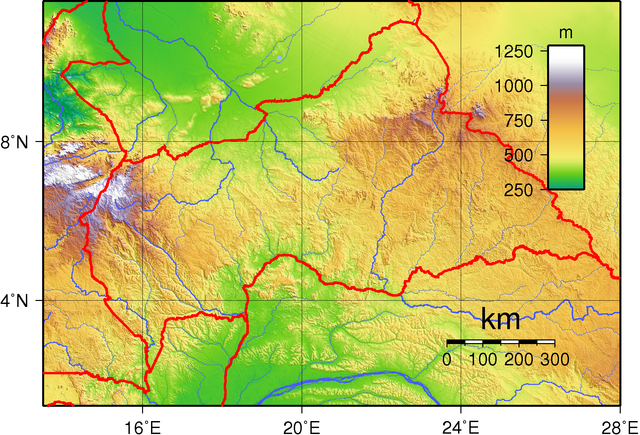Top Qs
Timeline
Chat
Perspective
Geography of the Central African Republic
From Wikipedia, the free encyclopedia
Remove ads
The Central African Republic is a landlocked nation within the interior of the African continent. It is bordered by Cameroon, Chad, Sudan, South Sudan, the Democratic Republic of the Congo and the Republic of the Congo. Much of the country consists of flat, or rolling plateau savanna, about 1,640 feet (500 m) above sea level. In the northeast are the Fertit Hills, and there are scattered hills in the southwestern part of the country. To the northwest is the Karre Mountains (also known as Yade Massif), a granite plateau with an altitude of 3,750 feet (1,143 m).
This article needs additional citations for verification. (August 2016) |


At 622,984 square kilometres (240,535 sq mi), the Central African Republic is the world's 45th-largest country (after Somalia). It is comparable in size to Ukraine.
Much of the southern border is formed by tributaries of the Congo River, with the Mbomou River in the east merging with the Uele River to form the Ubangi River. In the west, the Sangha River flows through part of the country. The eastern border lies along the edge of the Congo-Nile watershed.
In the Central African Republic forest cover is around 36% of the total land area, equivalent to 22,303,000 hectares (ha) of forest in 2020, down from 23,203,000 hectares (ha) in 1990. In 2020, naturally regenerating forest covered 22,301,000 hectares (ha) and planted forest covered 2,000 hectares (ha). Of the naturally regenerating forest 9% was reported to be primary forest (consisting of native tree species with no clearly visible indications of human activity). For the year 2015, 91% of the forest area was reported to be under public ownership and 9% private ownership.[1][2] In 2021, the rate of deforestation in the Central African Republic increased by 71%.[3] The forest is highly diverse and includes commercially important species of Ayous, Sapele and Sipo.
Remove ads
Climate
Summarize
Perspective

The climate of the Central African Republic is generally a tropical savanna climate (Köppen Aw), although there are areas with a tropical monsoon climate (Köppen Am) and in the north there is also a hot semi-arid climate (Köppen BSh). There is a wet season and a dry season, and the temperature is hot throughout the year. The northern areas are subject to harmattan winds, which are hot, dry, and carry dust. The tip of the northern regions have been subject to desertification. The remainder of the country is prone to flooding from nearby rivers. About one third of the Central African Republic's population do not have access to clean water.
Remove ads
Notes


Location: Central Africa, north of Democratic Republic of the Congo
- Area comparative
- Slightly smaller than Somalia
- Slightly larger than Ukraine
- Australia comparative: slightly more than 3/4 the size of New South Wales
- Canada comparative: slightly smaller than Manitoba
- United Kingdom comparative: slightly more than 21/2 times the size of the United Kingdom
- United States comparative: approximately 1/10 smaller than Texas
- EU comparative: approximately 1/5 larger than Spain
Land boundaries:
total:
5,920 km
border countries:
Cameroon 901 km, Chad 1,556 km, Democratic Republic of the Congo 1,747 km, Republic of the Congo 487 km, Sudan 174 km and South Sudan 1,055 km
Coastline: 0 km (landlocked)
Terrain: vast, flat to rolling, monotonous plateau; scattered hills in northeast and southwest
Elevation extremes:
lowest point:
Oubangui River 335 m
highest point:
Mont Ngaoui 1,420 m
Natural resources: diamonds, uranium, timber, gold, petroleum, hydropower
Land use:
arable land:
2.89%
permanent crops:
0.13%
other:
96.98% (2012 est.)
Irrigated land: 1.35 km2 (2003)
Total renewable water resources: 144.4 km3 (2011)
Freshwater withdrawal (domestic/industrial/agricultural):
total:
0.07 km3/yr (83%/17%/1%)
per capita:
17.42 m3/yr (2005)
Natural hazards: hot, dry, dusty harmattan winds affect northern areas; floods are common
Environment — current issues: tap water is not potable; poaching has diminished its reputation as one of the last great wildlife refuges; desertification
Environment — international agreements:
party to:
Biodiversity, Climate Change, Desertification, Endangered Species, Hazardous Wastes, Nuclear Test Ban, Ozone Layer Protection, Tropical Timber 94, Wetlands
signed, but not ratified:
Law of the Sea
Geography — note: landlocked; almost the precise center of Africa
Remove ads
Extreme points
This is a list of the extreme points of the Central African Republic, the points that are farther north, south, east or west than any other location.
- Northernmost point - unnamed location in the Aoukal river on the border with Chad, Vakaga Prefecture
- Easternmost point - unnamed location immediately East of the tripoint with South Sudan and the Democratic Republic of the Congo and south of the town of Ezo in South Sudan, Haut-Mbomou Prefecture
- Southernmost point - the tripoint with Cameroon and the Republic of Congo, Sangha-Mbaéré Prefecture
- Westernmost point - unnamed location on the border with Cameroon west of the town of Koundé in Central African Republic near Cameroon's Lokoti to Garoua Boulai road, Nana-Mambéré Prefecture
References
Wikiwand - on
Seamless Wikipedia browsing. On steroids.
Remove ads
